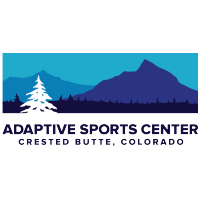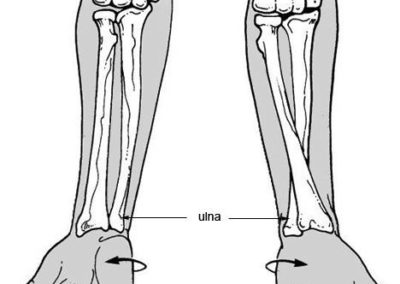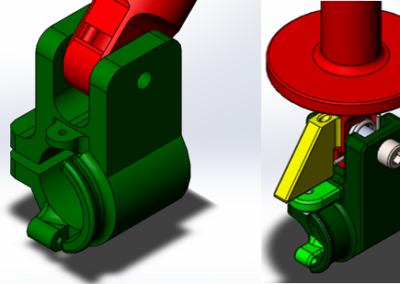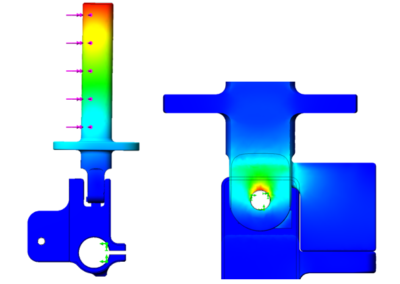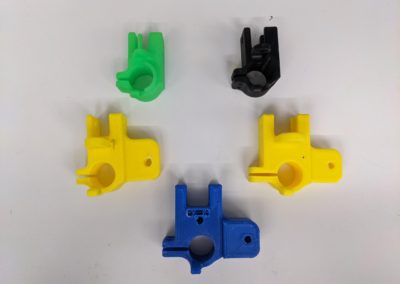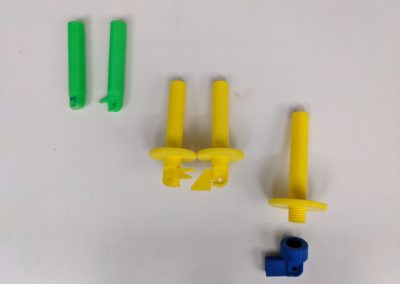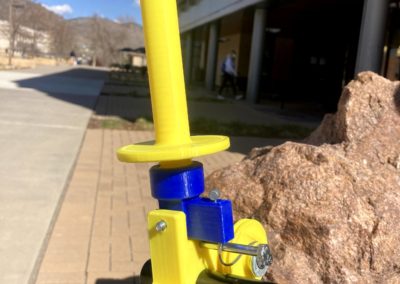Adaptive Mountain Bike Braking System
Overview
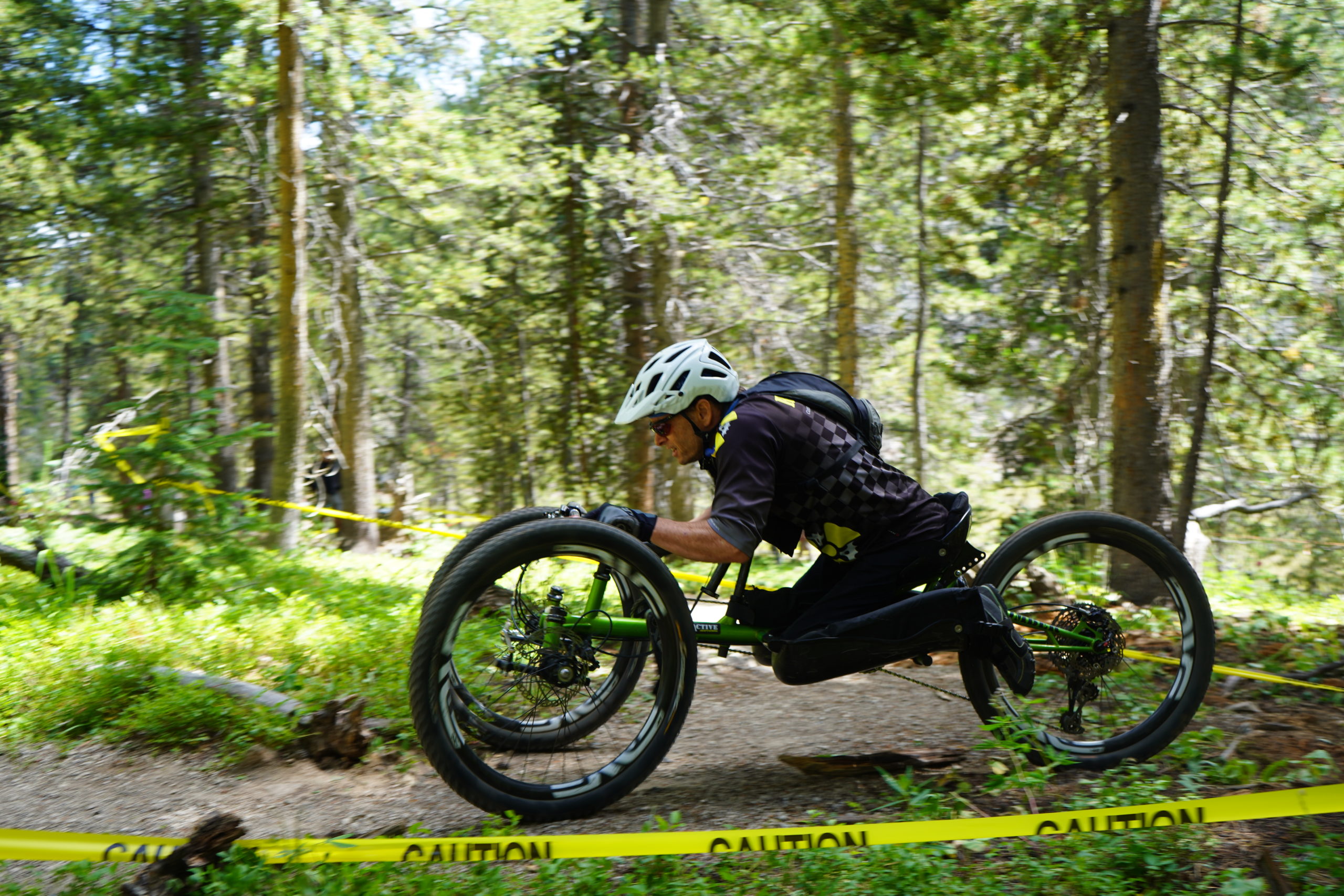
The thrill of mountain biking is attractive to many, regardless of physical ability or disability. Thankfully, much work has been done for adaptive mountain bikes; however, limitations in equipment mean limitations for some people. Some people with quadriplegia have limited ability to sit upright and use their torso muscles, as well as difficulty squeezing standard bike brakes [1].
The Adaptive Brakes Team is designing a mechanism to allow those with quadriplegia to easily pull the brakes on a gravity–powered downhill quad bike. The client wanted the team to design vertically oriented brakes that work with a supinating motion (rotating palms inward/outward) [2] to attach to a downhill quad bike with standard mountain bike handlebars. Over the past two semesters, the team has gone through many design iterations to create a vertical handle that is clamped to the handlebar and uses a guided cable to pull the brake lever when a supinating rotation is applied to the vertical handle.
Keep reading to find out more about the inspiration and process as we hope to make biking even more accessible to all.
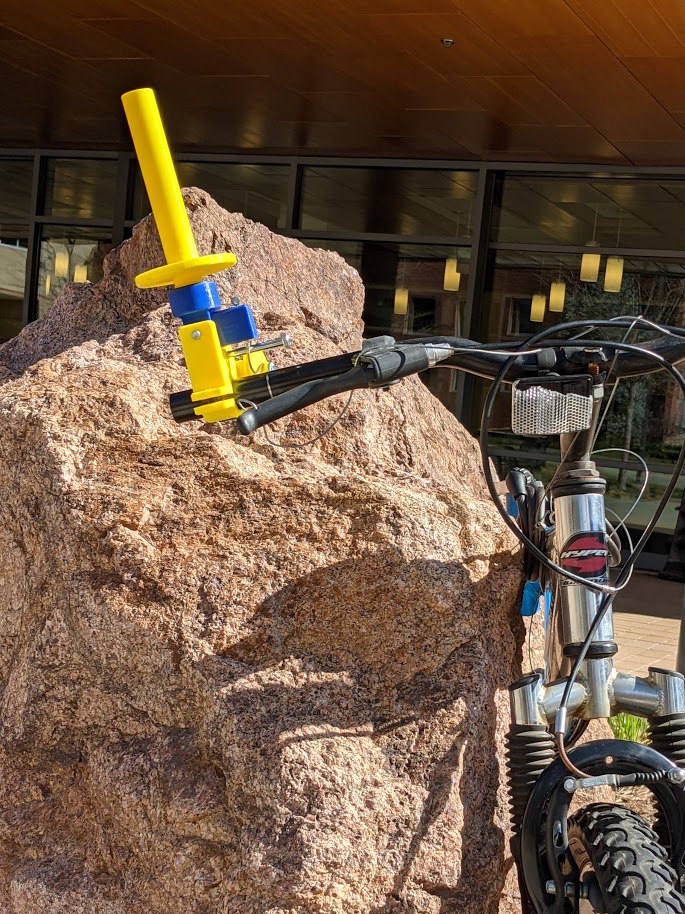
Live Zoom Chat
Use the link below to join us live from 8:00 – 10:30 a.m. on April 29th, 2021.
Join from PC, Mac, Linux, iOS or Android: https://mines.zoom.us/j/8507212177
Or iPhone one-tap: 16699006833,8507212177# or 12532158782,8507212177#
Or Telephone:
Dial: +1 669 900 6833 (US Toll) or +1 253 215 8782 (US Toll)
Meeting ID: 850 721 2177
International numbers available: https://mines.zoom.us/u/adIwIbW4u8
Or a H.323/SIP room system:
H.323: 162.255.37.11 (US West) or 162.255.36.11 (US East)
Meeting ID: 850 721 2177
Team Members
- Ian Olson
- Chance Reeves
- Nicholas Dennehy
- Elissa Himes
- Garett Brister
- Ryan Middle
- Quin Guy
The Client
- Adaptive Sports Center
Crested Butte, CO
Acknowledgements
Project Advisor: Chelsea Salinas
Technical Advisor: Dr. Joel Bach
Donations Made by: Mines HCDS
Video
Elevator Pitch
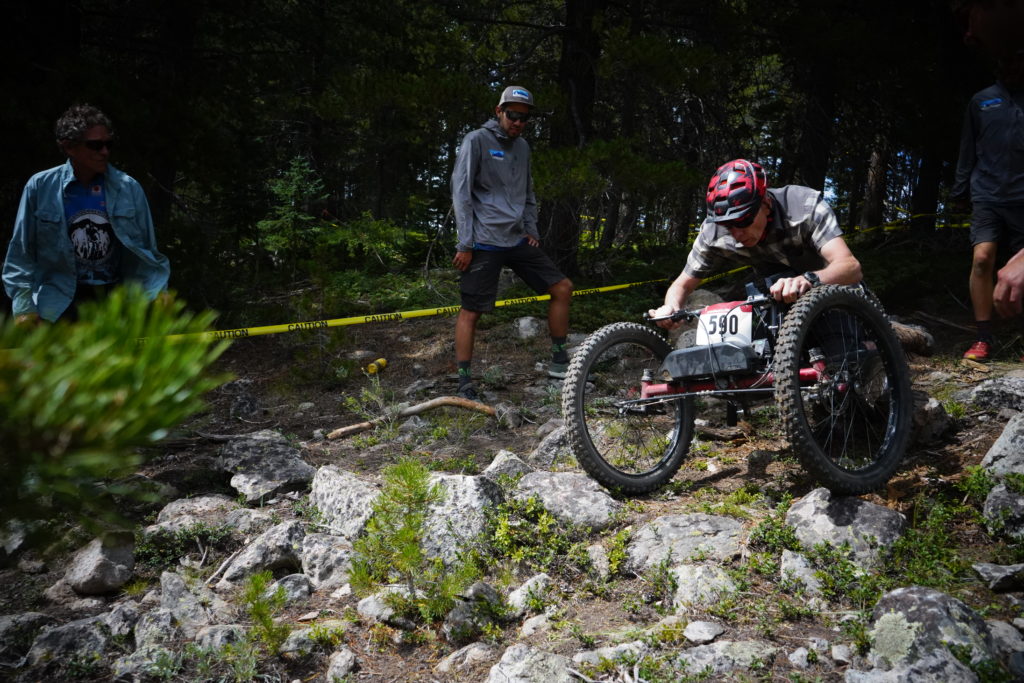 Adaptive mountain biking provides a recreational outlet for people with disabilities. For those who enjoy the descent, quad bikes are an excellent option, as it allows those who lack lower extremity control the ability to enjoy going downhill fast.
Adaptive mountain biking provides a recreational outlet for people with disabilities. For those who enjoy the descent, quad bikes are an excellent option, as it allows those who lack lower extremity control the ability to enjoy going downhill fast.
However, current quadricycles require sufficient grip strength to utilize the brakes on the bike. This posed an issue for Adaptive Sports Center in Crested Butte, whose mission is to improve the quality of life for people with disabilities through participation in outdoor activities [3]. With no viable alternative for this problem, they reached out to the Human-Centered Design Studio in hopes of finding an effective way for those with limited grip strength or upper body control a way actuate the brakes.
The proposed solution is to let the riders use a supinating motion of their arms to use the brakes. The rider will hold on to vertical handles that use a cable routed through a pulley to pull the standard brake levers when these vertical handles are pulled via a supinating motion. This gives the rider full control over the brakes without needing to squeeze any levers, but instead rotate their arms. The finalized design will give Adaptive Sports Center the opportunity to provide the necessary adaptive equipment to a wider range of riders.
Design Approach
The original goal for this project was to create a fully functioning supinating brake system for use on quad bikes with mobility and grip compromised users in mind. The team worked towards this goal by employing rapid prototyping via fused deposition modeling 3D printing so that new ideas could be tested in quick succession. Numerous design iterations were conducted, and basic lab validation tests guided further model changes. 3D printed models of the device were created one to two times per week. Then, the models were assembled and tested for function, safety, and ease of use by the team. Often, issues with tolerance, performance, and safety were the main reasons new design elements were introduced.
Due to the criticality of this system to user safety, these testing iterations were carried out with meticulous detail to ensure adequate brake engagement. As such, this project has become a proof of concept due to the extensive iteration. We found that splitting up tasks based on individual strengths allowed the team to successfully iterate through ideas quickly. While much of the team contributed to CAD modifications, the FEA simulations and 3D printing were delegated to several team members with in-depth experience on those subjects. It was determined that an in-service model could not be achieved due to the time constraints and numerous laboratory design tests. A proof-of-concept model was created instead to demonstrate the ability of the system to actuate a brake lever on a stationary bike.
Finite Element Analysis (FEA) was used to model a lower bound stress throughout the device to help the team understand where stress concentrations would occur. Due to the complex geometry and manufacturing methods utilized in the project (Fused Deposition Modeling, or FDM, 3D printing with carbon fiber reinforcement) final validation will be completed via load testing on the full-scale final prototype. Verification calculations using Mechanicals of Materials were conducted by approximating various members as simplified static members. This, along with a high factor of safety (FOS), helped the team ensure that the device was extremely safe for use. This FOS is acceptable to the team as research shows a FOS of 3-4 would be required “for use with materials where properties are not reliable” such as with FDM 3D printed materials [4].
Design Solution
The main components of the vertical braking system are as follows: The handle (black), the hand rest (red), the clamping part (dark green), the pulley (blue), cable guides (light green), cable lever (yellow) and a couple of pieces of hardware.
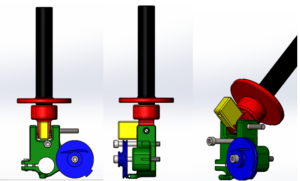
The system includes a dual-radius cable pulley mechanism (blue), a 90-degree torsion spring (not shown), and standard 22.2 mm bike handle grips to slide on the vertical handles (black). The handle screws out into the hand rest for ease of assembly and modularity in case of handle fracture. This handle will be 3D printed to be the diameter (22.2mm) – which is the diameter of a standard mountain bike handlebar – and length (150mm) – which is the maximum length of a lock-on bike grip [5] – to enable easy installation of standard bike grips. When rotated in a supinating motion, the handle returns to vertical via a 5 in-lb spring force from the 90° torsion spring seated within the handle.
The hand rest at the base of the handle in red will allow the rider to rest their wrist during a ride and is 82 mm in diameter based on the average human fist dimensions [6]. It attaches to the bike handlebars using the clamping mechanism shown in dark green. The clamping part is sized to fit standard mountain bike handlebars with two lateral bolts. Early iterations of the cable pull system included small protrusions meant to pull the cable like a lever arm; however, various modifications were made to the mechanism to lengthen the arc length of cable pull. The final solution includes a pulley, with slots to enable cable travel between small and large pulley radii, as well as a cable lever. This solution can achieve full engagement of the bike brakes when the handle is supinated 45° from vertical.
Minor interference between mated components was a barrier worked through to ensure smooth supination of the handle. Additionally, tolerancing issues with 3D printing small cable guides caused unwanted friction, leading to multiple tolerancing modifications. While the final design was initially intended to be either CNC machined or cast/molded (or have components of both as needed), the model demands complexity in order to perform the operations required and does not allow for either of these manufacturing processes. Due to this, the main components of the vertically oriented quad-brakes solution will be 3D printed using high-strength and high-temperature carbon fiber-reinforced nylon Onyx filament on a MarkForged 3D printer.
This design offers the user the ability to utilize the existing mountain bike braking system with little to no alterations required, a simple installation process, efficient functionality, and robust construction. With a rotation of the arm, the existing brake lever pulls in, helping the bike come to a stop. This design has addressed concerns with previous designs, considered existing standards and dimensions, and adapted to challenges discovered along the way.
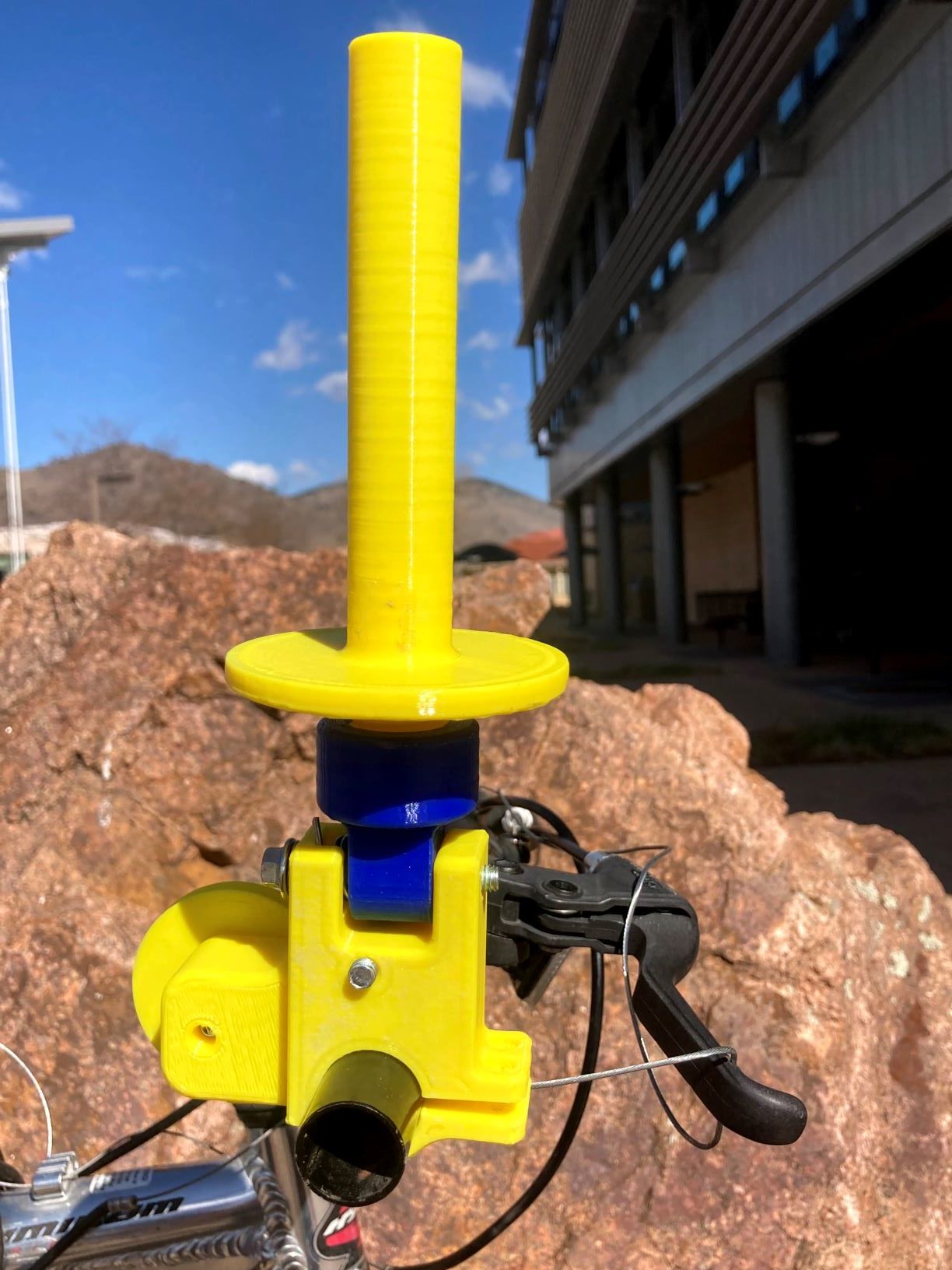
Next Steps
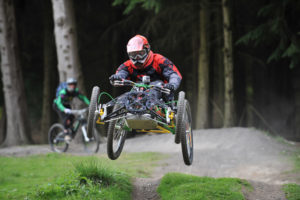 The remaining work for the quad brakes is additional testing, as well as a slight redesign of a critical subsystem. A longstanding issue within the design process was generating enough cable pull to effectively actuate the existing brakes on the quad bike. The team decided on adding a pulley system to increase the cable pull. While this did increase the amount of cable pull by 200%, it introduced an increased amount of friction that could not be overcome. Future work will involve finding a better solution to provide enough pull length while minimizing the amount of friction in the design. The team’s next steps also lie in conducting tests on a quadricycle, as well as printing the design using carbon fiber–reinforced nylon Onyx filament. Once the team mitigates the friction and pulley issues, the design will be printed using this filament, and testing can begin on quadricycles, where we will gain valuable feedback to further refine the design.
The remaining work for the quad brakes is additional testing, as well as a slight redesign of a critical subsystem. A longstanding issue within the design process was generating enough cable pull to effectively actuate the existing brakes on the quad bike. The team decided on adding a pulley system to increase the cable pull. While this did increase the amount of cable pull by 200%, it introduced an increased amount of friction that could not be overcome. Future work will involve finding a better solution to provide enough pull length while minimizing the amount of friction in the design. The team’s next steps also lie in conducting tests on a quadricycle, as well as printing the design using carbon fiber–reinforced nylon Onyx filament. Once the team mitigates the friction and pulley issues, the design will be printed using this filament, and testing can begin on quadricycles, where we will gain valuable feedback to further refine the design.
Check out the Adaptive Sports Center of Crested Butte and their upcoming Adaptive MTB World Championships! Click this link for more information.
Meet the Team
Ian Olson
 Ian is a graduating senior in Mechanical Engineering. He is currently a member of the Mines club baseball team and a teaching assistant in the Mines machine shop. Upon graduation, Ian plans to return to an internship in the manufacturing industry prior to his return to graduate school at CSM in the fall. When he is not busy, he likes to ski, fish, and bike in the mountains.
Ian is a graduating senior in Mechanical Engineering. He is currently a member of the Mines club baseball team and a teaching assistant in the Mines machine shop. Upon graduation, Ian plans to return to an internship in the manufacturing industry prior to his return to graduate school at CSM in the fall. When he is not busy, he likes to ski, fish, and bike in the mountains.
Chance Reeves
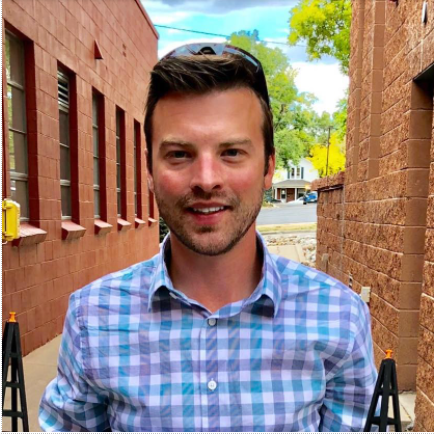 Chance is a Colorado native pursuing a master’s degree in mechanical engineering with focus in robotics from Colorado School of Mines. As an unconventional college student, Chance brings his years of technical experience and managing teams in the automotive industry to Mines. Chance is the president of the Maker Society as well as manager of the 3D printing projects students of all engineering disciplines bring into the Blaster Design Factory. In his free time, if he is not working on house projects, Chance often finds himself designing, coding, and bringing aspects of mechatronics to life.
Chance is a Colorado native pursuing a master’s degree in mechanical engineering with focus in robotics from Colorado School of Mines. As an unconventional college student, Chance brings his years of technical experience and managing teams in the automotive industry to Mines. Chance is the president of the Maker Society as well as manager of the 3D printing projects students of all engineering disciplines bring into the Blaster Design Factory. In his free time, if he is not working on house projects, Chance often finds himself designing, coding, and bringing aspects of mechatronics to life.
Nicholas Dennehy
 Nicholas is afirst-semester senior in Mechanical Engineering with a desire to enter the aerospace or automotive industry with an emphasis in structural analysis. A member of Mines Cycling and Formula SAE, he enjoys going fast and learning the science of how to go faster. As a Coast Guard veteran, Nicholas brings project management skills and a desire to help those in need, and the Human Centered Design Studio brings those traits to the forefront.
Nicholas is afirst-semester senior in Mechanical Engineering with a desire to enter the aerospace or automotive industry with an emphasis in structural analysis. A member of Mines Cycling and Formula SAE, he enjoys going fast and learning the science of how to go faster. As a Coast Guard veteran, Nicholas brings project management skills and a desire to help those in need, and the Human Centered Design Studio brings those traits to the forefront.
Elissa Himes
 Elissa is a graduating senior in Mechanical Engineering with a minor in Robotics. After graduating, she plans to complete an internship in the aerospace industry before continuing her education at Mines with a master’s degree in Robotics. Elissa enjoys mountain biking and hiking in her free time.
Elissa is a graduating senior in Mechanical Engineering with a minor in Robotics. After graduating, she plans to complete an internship in the aerospace industry before continuing her education at Mines with a master’s degree in Robotics. Elissa enjoys mountain biking and hiking in her free time.
Garett Brister
 Garett is a graduating senior in Mechanical Engineering. He is an avid mountain biker and has enjoyed racing for the Mines club cycling team. His primary career interest lies in the aerospace industry, and after graduation he plans to continue his internship in the space industry before continuing to graduate school at CSM.
Garett is a graduating senior in Mechanical Engineering. He is an avid mountain biker and has enjoyed racing for the Mines club cycling team. His primary career interest lies in the aerospace industry, and after graduation he plans to continue his internship in the space industry before continuing to graduate school at CSM.
Ryan Middle
 Ryan is another first-semester senior in Mechanical Engineering with a minor in Biomechanical Engineering, with plans of pursuing a PhD in biomechanics, specifically injury mechanics and rehabilitation. He enjoys skiing, mountain biking, and anything outdoors.
Ryan is another first-semester senior in Mechanical Engineering with a minor in Biomechanical Engineering, with plans of pursuing a PhD in biomechanics, specifically injury mechanics and rehabilitation. He enjoys skiing, mountain biking, and anything outdoors.
Quin Guy
 Quin is a first-semester senior in Mechanical Engineering. He is an avid photographer and bowler and has traveled across the country with the Mines Bowling Team. His interests lie in the practical application of thermodynamics, and he plans to return to Mines for a Masters in thermal fluid systems.
Quin is a first-semester senior in Mechanical Engineering. He is an avid photographer and bowler and has traveled across the country with the Mines Bowling Team. His interests lie in the practical application of thermodynamics, and he plans to return to Mines for a Masters in thermal fluid systems.
Citations
[1] “Quadriplegia and Paraplegia,” Winchester Hospital, [Online]. Available: https://www.winchesterhospital.org/health-library/article?id=96908. [Accessed 4 March 2019].
[2] B. Stride and M. Stride, “Wrist Movements,” Ergo Vancouver. [Online]. Available: http://www.ergovancouver.net/wrist_movements.htm
[3] “Mission and Vision,” [Online]. Available: https://www.adaptivesports.org/about-us/mission-and-vision
[4] Engineering ToolBox, “Factors of Safety,” Engineering ToolBox, 2010. [Online]. Available: https://www.engineeringtoolbox.com/factors-safety-fos-d_1624.html. [Accessed: 02-Mar-2021].
[5] Strange, J. (2019, June 21). Find the right size grips for your mountain bike. Retrieved April 05, 2021, from https://www.mtbikeprogress.com/are-all-mountain-bike-grips-the-same-size
[6] D. Weatherspoon, “What’s the Average Hand Size for Men, Women, and Children?,” https://www.healthline.com/, 07-Aug-2019. [Online]. Available: https://www.healthline.com/health/average-hand-size#glove-sizing. [Accessed: 01-Apr-2021].
